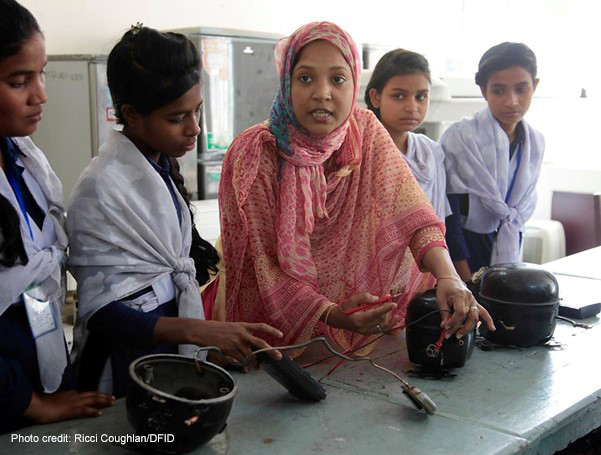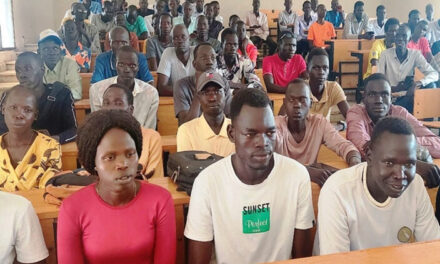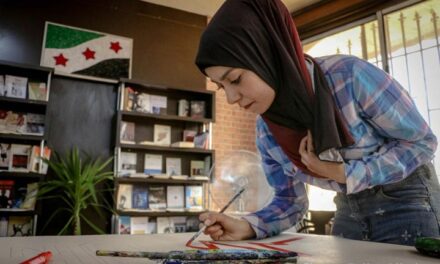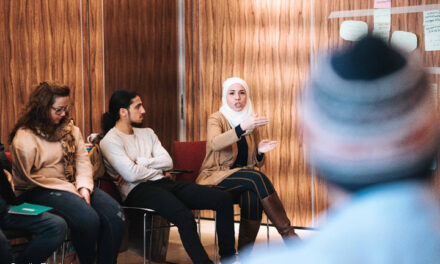This article is written by the British Council funded project team: Dr Prithvi N. Shrestha (The Open University), Dr Claire Kotecki (The Open University), Prof Rubaiyat Jahan (University of Rajshahi), Prof Halida Homyara (University of Rajshahi), Prof Kristina Hultgren (The Open University), and Nasreen Sultana Mitu (University of Rajshahi). It is based on their initial phase of the research project ‘Access, barriers and gender equality in STEM education at a Bangladeshi University’.
UNESCO reported in 2017 that women’s participation in STEM education globally is only 35%. Their participation in STEM education in Bangladesh is one of the lowest in South Asia. In most low-income countries, men still outnumber women in accessing higher education including Bangladesh (BANBEIS, 2021) although higher education enrolment for women has improved in recent years. Institutional and cultural practices continue to give high social power to men and make women/feminine subordinates. Increasing female participation in STEM is not only important for social justice reasons, enabling women to access higher-earning careers and an international marketplace and increasing individual scientific literacy and agency, but equally, STEM disciplines and industries are enriched by a gender-diverse perspective.
While prior studies focusing on female participation in STEM education have identified factors affecting gendered uptake of higher degrees both in South Asia and worldwide, no studies have focused on identifying potential factors leading to Bangladesh’s strong gender imbalance at university level.
This blog discusses preliminary work in an ongoing research partnership project between The Open University, UK and Rajshahi University, Bangladesh (funded by the British Council) exploring the factors that hamper or facilitate young women’s participation in STEM education at Rajshahi University in agrarian northern Bangladesh.
What are the main issues?
In most countries, despite the increase of female enrolment figures in higher education, their enrolment is biased towards ‘humanities’ subjects rather than STEM. Bangladesh is not an exception. Even the national figures for higher education enrolment show that there is a clear gendered pattern: 2,654,603 males and 2,036,273 females in 2020 (University Grants Commission report 2021). The enrolment of female students is significantly lower at Rajshahi: 24,309 male vs 13,982 female in 2020. Although we have not yet been able to obtain the STEM enrolment figures, it is likely that female students will have far lower participation than their male counterparts.
Our approach
We recognise that ensuring that our work accurately represents the specific challenges faced in Bangladesh requires a dual-institution approach adopted through equal collaboration between The Open University (UK) and Rajshahi University (Bangladesh), with reciprocal expertise input. An initial national policy survey was carried out to identify relevant governmental policies and this will be analysed alongside Rajshahi University’s internal policies and procedures using a recognised framework to understand the institutional approach and engagement with proactive gender equality and monitoring. In parallel, 206 existing undergraduate and postgraduate female (n = 104) and male (n = 102) STEM students at the university were surveyed covering 6 key areas: demographic information, study choices, educational environment, study-life balance, discrimination and harassment, attitudes and social norms, funding and perceptions (adapted from UNESCO SAGA survey and Verdugo-Castro et al (2022).
What we have found out so far
Despite a commitment at the policy level to enhance female participation in Bangladeshi higher education (National Women Development Policy 2011, National Education Policy 2010), we have not found any policy that explicitly seeks to promote gender equality in STEM education. The National Women Development Policy emphasises women’s empowerment. However, the National Education Policy has only an oblique reference to eradicating gender disparity, without iterating an actionable strategic approach. Equally, it is important to note that policy on gender equality in higher education or STEM education was not available.
Rajshahi University’s urban-agrarian catchment was reflected in the survey respondents, with an equal response level of students from rural, urban and semi-urban areas. A lower proportion of the respondents’ mothers completed university education in comparison to their fathers, and this was particularly stark when limiting the responses to STEM degrees. Overall, a low percentage of parents have completed STEM degrees in comparison to non-STEM degrees, whatever their gender. Parents and extended family were cited most frequently as playing an important role in shaping study choices and are overwhelmingly the primary source of financial support for students. Taken together, these indicate that family members and upbringing are influential in the choices made by female and male students and potentially impact the pathway chosen.
What were STEM students’ experience and perceptions?
Over 90% of female and male students surveyed have always considered a STEM career and a higher percentage of female students were supported in the admission process in comparison to male students (79.4% – female vs 69.4% – male).
While both genders have similar ratings when describing their experiences with the curriculum and programme quality, when asked to rate their experiences with regard to equitable treatment based on gender and the study environment and attitudes of other students, male student responses are more strongly negative (11.2% of male students report a poor experience of gender-equal treatment vs 2.0% of female students; 12.2% of male students report a poor experience relating to the study environment vs 2% of female students).
A higher percentage of male students report gender-discrimination in assessment (21.4% male vs 14.7% female), whilst a higher number of female students report gender-discrimination in receipt of awards (11.8% female vs 8% male), feeling isolated and ignored (10% female vs 6% male), pay levels (13.7% female vs 2% male) and wrongful dismissal (21.6% female vs 2% male).
15.7% of male students do not believe that female and male students performing the same are treated equally (vs 4.1% of female students). This gender trend is also seen when asking about equal treatment relating to ethnicity, race and religion (13.3% male vs 2.9% female).
17.7% of female students report they have been the recipient of gender-based rude or offensive remarks compared to 8.2% of male students. This gender divide increases to 32.4% female compared to 9.0% male students who report being the recipient of unwanted leers, sexual comments, noises and gestures.
The experience of gender-based discrimination in schools and universities is a strong theme. However, male perceptions of gender discrimination suggest that male peer-response to female achievement in STEM is complicated. Female students report higher levels of unwanted negative gender-based direct interaction throughout their educational career, which has the potential to discourage female students from entering male-dominated environments. These are themes that will be explored further in detailed analysis and focus group work.
Preliminary conclusion and implications
At this stage it is evident that a clear gender equality policy for higher education is required, with more specific details, national educational gender equity goals and a strategic pathway to achieving them that can be adopted within institutions.
It is necessary to explore the stark difference between genders in STEM degree uptake with further analysis. In particular, it is important to understand why male students believe that female student achievement is not necessarily fairly represented and how this links to the subconscious reception of female students in a traditionally male-dominated field.





